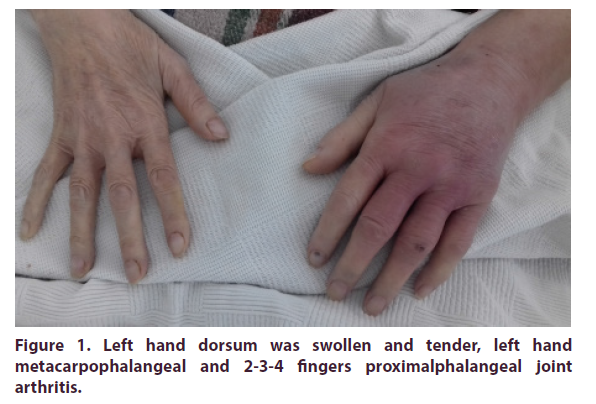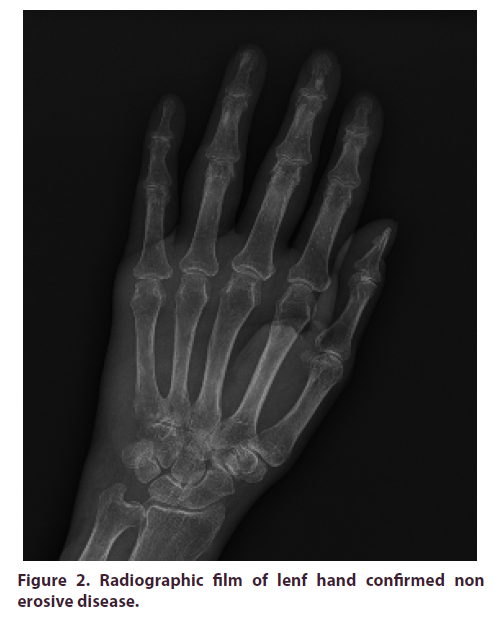Case Report - International Journal of Clinical Rheumatology (2022) Volume 17, Issue 1
A female case of Remitting seronegative symmetrical synovitis with pitting edema (RS3PE) and tumour of breast
- *Corresponding Author:
- Muhammet Limon
Division of Rheumatology, Kahramanmaras City Hospital, Kahramanmaras, Turkey
E-mail: dr_mlimon@hotmail.com
Received: 30-Dec-2021, Manuscript No. fmijcr-22-50948; Editor assigned: 03-Jan-2022, PreQC No. fmijcr-22-50948(PQ); Reviewed: 17-Jan-2022, QC No. fmijcr-22-50948; Revised: 22-Jan-2022, Manuscript No. fmijcr-22-50948(R); Published: 28-Jan-2022, DOI: 10.37532/1758-4272.2022.17(1).001-003
Abstract
RS3PE; It is a syndrome with sudden onset, pitting edema on the hands and feet and symmetric arthritis, usually in men over 50 years of age, with a high erythrocyte sedimentation rate and generally RF negativity. This disease responds very well to corticosteroid. While RS3PE is almost always a symmetric disease of the upper extremities, it may rarely present in a unilateral fashion. There are multiple underlying factors causing this rare entity but it has very close associations with hematological and solid organ malignancies. So far its association with solid tumours and hematological malignancies has been reported. This case is presented because of the unilateral occurrence of RS3PE in the course of breast cancer.
Keywords
RS3PE • tumour of breast • arthritis
Introductıon
Remitting seronegative symmetrical synovitis with pitting edema (RS3PE) was initially described by Mc Carty et al. in 1985 as one of the subgroups of seronegative rheumatoid arthritis [1].This disease, which responds very well to corticosteroids, is predominantly seen in elderly men. While RS3PE is almost always a symmetric disease of the upper extremities, it may rarely present in a unilateral fashion. Late-onset rheumatoid arthritis, crystal arthropathies, polymyalgia rheumatica should be considered in the differential diagnosis of RS3PE cases. There are multiple underlying factors causing this rare entity but it has very close associations with hematological and solid organ malignancies. So far its association with solid tumours and hematological malignancies has been reported. This case is presented because of the unilateral occurrence of RS3PE in the course of breast cancer.
Case
A 72 year old female patient with known breast cancer diagnosis, presented to rheumatology outpatient clinic with complaints of tender and swollen in her dorsum of left hand and fingers. It was learned that finger deformity started one week ago and progressed in time. It was accompanied by pain and stiffness. In physical examination, left hand dorsum was swollen and tender, left hand metacarpophalangeal and 2-3-4 fingers proximalphalangeal joint arthritis (Figure 1). Radiographic films of lenf hand confirmed non erosive disease (Figure 2). Laboratory examination results were as follows: Leucocyte:15800K/Ul, neutrophil: 4200K/Ul, hemoglobin:10.8gr/dl, thrombocyte:240.000K/Ul, creatinine:1,3 mg/dl, CRP:131 mg/L (N:0-8), sedimentation: 126 mm/h. Among autoimmune markers, ANA, RF and anti –CCP were found to be negative. No recurrence of malignancy was observed on mammography imaging. She was the diagnosed with RS3PE and administered methylprednisolone 20 mg/day. The dose of corticosteorids was decreased for 20% weekly. Last laboratory examination results were as follows: Leucocyte:10800K/Ul, neutrophil:4200K/ Ul, hemoglobin:11.3 gr/dl, thrombocyte :240.000K/ Ul, creatinine:0,67 mg/dl, CRP:3 mg/L (N:0-8), sedimentation: 23 mm/h. RS3PE is still in remission and the patient is being followed with medical treatment methylprednisolone 4 mg daily.
Discussion
RS3PE; It is a syndrome with sudden onset, pitting edema on the hands and feet and symmetric arthritis, usually in men over 50 years of age, with a high erythrocyte sedimentation rate and generally RF negativity. The etiopathogenesis of RS3PE is not clearly known. Genetic factors, malignancies, drugs, environmental factors, drugs, infections and cytokines have been defined as risk factors [2]. RS3PE can be seen as a stand-alone disease or can be seen simultaneously with various diseases. Olivo et al. described endometrial adenocarcinoma in a patient with RS3PE who had a poor response to low-dose steroids [3]. In this patient, clinical and laboratory signs of RS3PE disappeared after total hysterectomy. Pitting edema is the most specific property. Edema of both hand and foot have been reported. The most commonly affected joints are the wrist, ankle, metacarpophalangeal, and proximal interphalangeal joints. It is thought that it does not lead to permanent damage in joints, but mild residual joint limitations may occur. Until Pariser and Canosa reported two unilateral RS3PE cases, it was regarded as a symmetrical entity [4]. Then, in the case series of Finnell and Cuesta, asymmetrical involvement in lower extremities was reported [5]. The joint involvement of our case was unilateral and in the upper extremity. Late-onset rheumatoid arthritis, crystal arthropathies, polymyalgia rheumatica should be considered in the differential diagnosis of RS3PE cases. In connection with RS3PE syndrome, malignancies such as hematological (leukemia, lymphoma), myelodysplastic syndrome and gastric and pancreatic cancer may develop.
In RS3PE syndrome, acute phase reactants such as sedimentation and CRP increase. Autoimmune markers ANA, RF and ANTI-CCP are negative. In the study of Schaeverbeke et al. in 1995, HLA-A2 positivity was found to be 82%. The HLA-B7 phenotype is approximately 50% positive [6,7]. IL-6, serum VEGF, MMP-3 levels were found to be higher in patients with RS3PE and adenocarcinoma compared to controls [8- 10]. In the case we presented, acute phase reactants were high and autoimmune markers ANA, RF and anti-CCP were found to be negative.
In RS3PE syndrome, erosive and degenerative changes are not observed on radiological direct radiographs of the joints. Color Doppler and MRI can be used to evaluate joint inflammation in these patients. In the case we presented, no erosive changes were observed in the direct radiograph.
Good response to low-dose corticosteroids is one of the characteristic features of the disease in RS3PE patients without underlying disease. It was determined that 95% of 108 RS3PE cases performed by Amodeo et al. were given corticosteroids [11]. As the treatment period, it was determined that two-thirds of the cases were treated for three to six months. Although it is suggested that non-steroidal anti-inflammatory drugs and hydroxychloroquine may be beneficial, immunosuppressants such as methotrexate are rarely needed for treatment. Clinical regression has been observed in RS3PE patients with malignancy when the underlying malignancy was treated. Our case had a very dramatic response to steroids and had RS3PE years after breast cancer. Our case was administered methylprednisolone 20 mg/day. The dose of corticosteorids was decreased for 20% weekly. RS3PE is still in remission and the patient is being followed with medical treatment methylprednisolone 4 mg daily.
Conclusion
To date, coexistence of RS3PE and malignancy has been reported. This case is presented because of the unilateral occurrence of RS3PE in the course of breast cancer. It should be kept in mind that unilateral RS3PE may develop in the course of malignancy.
Funding
This study did not require any funding
Conflict of interest
All the authors are no conflicts of interest related to this manuscript. Ethics: This article does not contain any studies with human participants or animals performed by any of the authors. This is a case report, and the patient was informed and fully consents to publication.
References
- McCarty DJ, O'Duffy JD, Pearson L et al. Remitting seronegative symmetrical synovitis with pitting edema. RS3PE syndrome. JAMA. 254,2763–2767 (1983).
- Kenzaka T. The Relationship between Remitting Seronegative Symmetrical Synovitis with Pitting Edema and Vascular Endothelial Growth Factor and Matrix Metalloproteinase 3. Intern Med. 59,1021-1022 (2020).
- Olivo D, Mattace R. Concurrence of benign edematous polysynovitis in the elderly (RS3PEsyndrome) and endometrial adenocarcinoma. Scand J Rheumatol. 26(1),67-68 (1997).
- Pariser KM, Canosa JJ. Remitting seronegative symmetrical synovitis with pitting edema-two cases of RS3PE syndrome. J Rheumatol. 18(8),1260-1262 (1991).
- Finnell JA, Cuesta IA. Remitting seronegative symmetrical synovitis with pitting edema (RS3PE) syndrome:a review of the literature and a report of three cases. J Foot Ankle Surg. 39,189–193 (2000).
- Schaeverbeke T, Vernhes JP, Bannwarth B et al. Is remitting seronegative symmetrical synovitis with pitting oedema (RS3PE syndrome) associated with HLA-A2? Br J Rheumatol. 34(9),889-890 (1995).
- Koeger AC, Karmochkine M, Chaïbi P. RS3PE syndrome associated with advanced ankylosing spondylitis. J Rheumatol. 22(2),375-376 (1995).
- Origuchi T, Arima K, Kawashiri SY et al. High serum matrix metalloproteinase 3 is characteristic of patients with paraneoplastic remitting seronegative symmetrical synovitis with pitting edema syndrome. Mod Rheumatol. 2(4):584-588 (2012).
- Sibilia J, Friess S, Schaeverbeke T et al. Remitting seronegative symmetrical synovitis with pitting edema (RS3PE): a form of paraneoplastic polyarthritis? J Rheumatol. 26(1),115-120 (1999).
- Arima K, Origuchi T, Tamai M et al. RS3PE syndrome presenting as vascular endothelial growth factor associated disorder. Ann Rheum Dis. 64(11),1653-1655 (2005).
- Amodeo MC , Poyato M, Rodríguez M. RS3PE syndrome: An update on its treatment using the presentation of a case. Semergen. 41(8),429-434 (2015).
Indexed at Google Scholar Cross Ref
Indexed at Google Scholar Crossref
Indexed at Google Scholar Crossref
Indexed at Google Scholar Crossref
Indexed at Google Scholar Crossref
Indexed at Google Scholar Crossref




